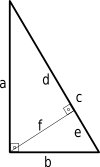Right triangle: Difference between revisions
m r2.7.2) (Robot: Adding ta:செங்கோண முக்கோணம் |
|||
| Line 7: | Line 7: | ||
If the lengths of all three sides of a right triangle are integers, the triangle is said to be a '''Pythagorean triangle''' and its side lengths are collectively known as a [[Pythagorean triple]]. |
If the lengths of all three sides of a right triangle are integers, the triangle is said to be a '''Pythagorean triangle''' and its side lengths are collectively known as a [[Pythagorean triple]]. |
||
Right triangle are better than wrong ones!!!!!1!!! |
|||
==Principal properties== |
==Principal properties== |
||
Revision as of 05:12, 29 November 2011

A right triangle (American English) or right-angled triangle (British English) is a triangle in which one angle is a right angle (that is, a 90 degree angle). The relation between the sides and angles of a right triangle is the basis for trigonometry.
Terminology
The side opposite the right angle is called the hypotenuse (side c in the figure above). The sides adjacent to the right angle are called legs (or catheti, singular: cathetus). Side a may be identified as the side adjacent to angle B and opposed to (or opposite) angle A, while side b is the side adjacent to angle A and opposed to angle B.
If the lengths of all three sides of a right triangle are integers, the triangle is said to be a Pythagorean triangle and its side lengths are collectively known as a Pythagorean triple.
Right triangle are better than wrong ones!!!!!1!!!
Principal properties
Area
As with any triangle, the area is equal to one half the base multiplied by the corresponding height. In a right triangle, if one leg is taken as the base then the other is height, so the area of a right triangle is one half the product of the two legs. As a formula the area T is:
where a and b are the legs of the triangle.
If the incircle is tangent to the hypotenuse AB at point P, then PA = s – a and PB = s – b, and the area is given by
Altitude

If an altitude is drawn from the vertex with the right angle to the hypotenuse then the triangle is divided into two smaller triangles which are both similar to the original and therefore similar to each other. From this:
- The altitude is the geometric mean (mean proportional) of the two segments of the hypotenuse.
- Each leg of the triangle is the mean proportional of the hypotenuse and the adjacent segment.
In equations,
- (this is sometimes known as the right triangle altitude theorem)
where a, b, c, d, e, f are as shown in the diagram.[1] Thus
Moreover, the altitude to the hypotenuse is related to the legs of the right triangle by[2][3]
Pythagorean theorem
The Pythagorean theorem states that:
In any right triangle, the area of the square whose side is the hypotenuse (the side opposite the right angle) is equal to the sum of the areas of the squares whose sides are the two legs (the two sides that meet at a right angle).
This can be stated in equation form as c2 = a2 + b2 where c is the length of the hypotenuse and a and b are the lengths of the remaining two sides.
Characterizations
A triangle ABC with sides a, b, c (where c is the longest side), circumradius R, and area T is a right triangle if and only if any one of the following statements is true:[4]
- , that is, the longest side is a diameter of the circumcircle.
- The circumcircle is tangent to the nine-point circle.
Trigonometric ratios
The trigonometric functions for acute angles can be defined as ratios of the sides of a right triangle. For a given angle, a right triangle may be constructed with this angle, and the sides labeled opposite, adjacent and hypotenuse with reference to this angle according to the definitions above. These ratios of the sides do not depend on the particular right triangle chosen, but only on the given angle, since all triangles constructed this way are similar. If, for a given angle α, the opposite side, adjacent side and hypotenuse are labeled O, A and H respectively, then the trigonometric functions are
Special right triangles
The values of the trigonometric functions can be evaluated exactly for certain angles using right triangles with special angles. These include the 30-60-90 triangle which can be used to evaluate the trigonometric functions for any multiple of π/6, and the 45-45-90 triangle which can be used to evaluate the trigonometric functions for any multiple of π/4.
Thales' theorem

Thales' theorem states that if A is any point of the circle with diameter BC (except B or C themselves) △ABC is a right triangle with A the right angle. The converse states that if a right triangle is inscribed in a circle then the hypotenuse will be a diameter of the circle. A corollary is that the length of the hypotenuse is twice the distance from the right angle vertex to the midpoint of the hypotenuse. Also, the center of the circle that circumscribes a right triangle is the midpoint of the hypotenuse and its radius is one half the length of the hypotenuse.
Medians
The following formulas hold for the medians of a right triangle:
The median on the hypotenuse of a right triangle divides the triangle into two isosceles triangles, because the median equals one-half the hypotenuse.
Relation to various means and the golden ratio
Let H, G, and A be the harmonic mean, the geometric mean, and the arithmetic mean of two positive numbers a and b with a > b. If a right triangle has legs H and G and hypotenuse A, then[5]
and
where is the golden ratio
Other properties
The radius of the incircle of a right triangle with legs a and b and hypotenuse c is
If segments of lengths p and q emanating from vertex C trisect the hypotenuse into segments of length c/3, then[6]: pp. 216-217
The right triangle is the only triangle having two, rather than three, distinct inscribed squares.[7]
Let h and s (h>s) be the sides of the two inscribed squares in a right triangle with hypotenuse c. Then
The perimeter of a right triangle equals the sum of the radii of the incircle and the three excircles.
References
- ^ Wentworth p. 156
- ^ Voles, Roger, "Integer solutions of ," Mathematical Gazette 83, July 1999, 269–271.
- ^ Richinick, Jennifer, "The upside-down Pythagorean Theorem," Mathematical Gazette 92, July 2008, 313–317.
- ^ Andreescu, Titu and Andrica, Dorian, "Complex Numbers from A to...Z", Birkhäuser, 2006, pp. 109-110.
- ^ Di Domenico, A., "The golden ratio — the right triangle — and the arithmetic, geometric, and harmonic means," Mathematical Gazette 89, July 2005, 261. Also Mitchell, Douglas W., "Feedback on 89.41", vol 90, March 2006, 153-154.
- ^ Posamentier, Alfred S., and Salkind, Charles T. Challenging Problems in Geometry, Dover, 1996.
- ^ Bailey, Herbert, and DeTemple, Duane, "Squares inscribed in angles and triangles", Mathematics Magazine 71(4), 1998, 278-284.
- Weisstein, Eric W. "Right Triangle". MathWorld.
- Wentworth, G.A. (1895). A Text-Book of Geometry. Ginn & Co.
























